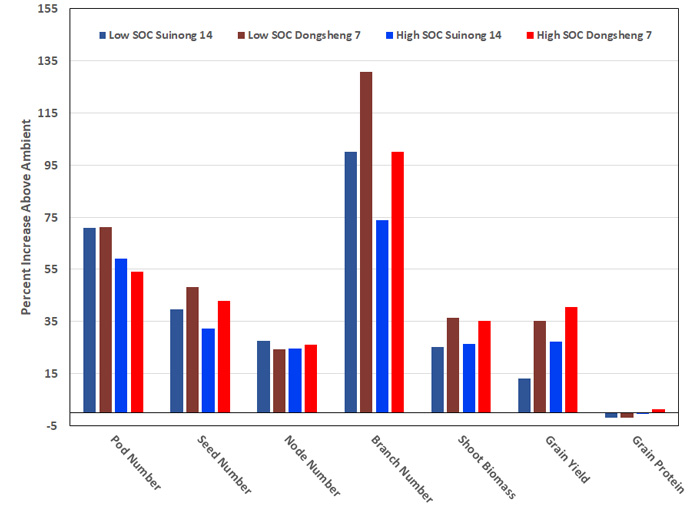| Follow @co2science |
Paper Reviewed
Jin, J., Li, Y., Liu, X., Wang, G., Tang, C., Yu, Z., Wang, X. and Herbert, S.J. 2017. Elevated CO2 alters distribution of nodal leaf area and enhances nitrogen uptake contributing to yield increase of soybean cultivars grown in Mollisols. PLoS ONE 12(5): e0176688.
As an important global agricultural crop, soybean has been widely studied by scientists seeking to improve its growth and yield; and a number of researchers have conducted CO2-enrichment experiments in this regard (see, for example, the many reviews we have posted here and here). The latest group to continue this long line of research is Jin et al. (2017), who investigated the growth response of two soybean cultivars to atmospheric CO2 enrichment.
Jin et al.'s experiment was conducted at the Northeast Institute of Geography and Agroecology, Chinese Academy of Sciences, Harbin, China, where soybean (Glycine max) cultivars Suinong 14 and Dongsheng 7 were grown in large pots filed with Mollisols containing two different soil organic carbon (SOC) contents (low, 10.4 mg g-1 SOC, or high, 45.5 mg g-1 SOC) in open-top chambers exposed to either ambient (380 ppm) or elevated (580 ppm) CO2 conditions. Their objective was "to investigate the effect of elevated CO2 on yield-related characteristics including dynamics of nodal leaf area and N uptake," and it was their hypothesis that elevated CO2 would greatly enhance the growth and yield of the two cultivars.
The results of their analysis are presented in the figure below. As can be seen there, elevated CO2 stimulated the pod number, seed number, node number, branch number, shoot biomass and grain yield of both soybean cultivars, independent of SOC conditions. In the words of Jin et al., this occurred because "elevated CO2 significantly altered the distribution of nodal leaf area with a significant increase of leaf area at the upper nodes and on branches." Consequently, they add, the "number of pods and seeds at these correspondent positions markedly increased, contributing to the yield gain under elevated CO2."
More surprising, however, are their findings pertaining to plant N assimilation and fixation. In this regard, the seven researchers remind us that "sufficient N uptake and transport to the seed are especially important for the yield gain under elevated CO2, given that N demand is intrinsically great in soybean, and [an] adequate supply of N is consequently vital to attain yield potential." Yet, despite a reduction in shoot N concentration under elevated CO2, indicative of a dilution effect and/or increased N demand by the two cultivars, Jin et al. report that "elevated CO2 did not significantly affect the protein (or N) concentration in soybean grains, indicating that N supply was adequate to maintain the grain quality." The most likely explanation as for why this counterintuitive finding was observed, is that "elevated CO2 facilitated the translocation of N into grains," thereby preserving the grain quality.
These findings suggest that, in the future, and given the right cultivar, soybean quantity will be enhanced without sacrificing its quality. And that is news worth reporting that you likely will not hear anywhere else!

Figure 1. The percentage increase in pod number, seed number, node number, branch number, shoot biomass, grain yield and grain protein due to elevated CO2 (580 ppm), relative to ambient air (380 ppm CO2), for two soybean cultivars (Shunong 14 and Dongsheng 7) grown in two Mollisols of different soil organic carbon (SOC; low = 10.4 mg g-1, high = 45.5 mg g-1). Source: Jin et al. (2017).




